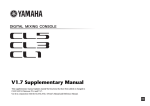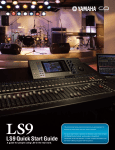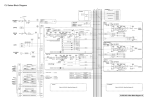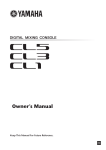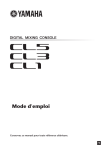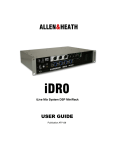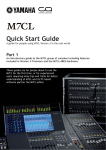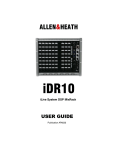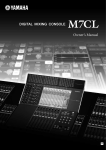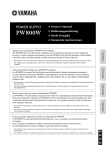Download Yamaha M7CL-48ES Specifications
Transcript
M7CL Specifications
General Specifications
Sampling Frequency
Internal: 44.1 kHz, 48 kHz
External: 44.1 kHz (–10%) to 48 kHz (+6%) <M7CL-32/48>
44.1 kHz (–2.5%) to 48 kHz (+2.5%) <M7CL-48ES>
Net Weight
M7CL-48:
50kg (110.23lbm)
M7CL-32:
42kg (92.59lbm)
M7CL-48ES: 46kg (101.41lbm)
Signal Delay
Fader
Fader Resolution
Less than 2.5 ms INPUT or OMNI IN to OMNI OUT (@Fs = 48 kHz)
100mm motorized x62 (46)
+10 to –138, –�dB (1024 steps/100 mm)
Power Requirements
(wattage)
M7CL-48:
300 W, 100V 50/60Hz
M7CL-32:
250 W, 100V 50/60Hz
M7CL-48ES: 150 W, 100V 50/60Hz
Maximum Voltage Gain
M7CL-32/48: 86 dB INPUT 1-48 to OMNI OUT
M7CL-48ES: 86 dB OMNI IN 1-8 to OMNI OUT 1-8
Power Requirements
(voltage and hertz)
Crosstalk (@1kHz)
M7CL-32/48/48ES -100dB*, -80dB Adjacent input Channels
M7CL-32/48/48ES -100dB*, -80dB Input to output
�*Crosstalk is measured with a 30 dB/octave filter @22 kHz
US/Canada: 120V 60Hz
Japan:
100V 50/60Hz
China:
110–240V 50/60Hz
Operation free-air
Temperature Range
+10 °C to +35 °C
Storage
Temperature Range
–20 °C to +60 °C
Included Accessories
Owner’s Manual, Dust cover, Power cord, Cord clamp
Optional Accessories
Meter Bridge MBM7CL, Mini-YGDAI cards *, Gooseneck Lamp LA1L
Power Supply PW800W, Power Supply Link Cable PSL360
Dimensions(W×H×D)
M7CL-48/48ES 1,274 (50 2/8) × 286 (11 2/8) × 701 (27 5/8) mm(in)
M7CL-32
1,060 (41 6/8) × 286 (11 2/8) × 701 (27 5/8) mm(in)
* Refer to the Yamaha professional audio website for information on supported I/O cards.
http://www.yamahaproaudio.com/
Korea: 220V 60Hz
Other: 110–240V 50/60Hz
Analog Input Characteristics
Input Terminals
GAIN
For Use With
Nominal
3 kΩ
50-600Ω Mics &
600Ω Lines
–82dBu (61.6 µV)
3 kΩ
50-600Ω Mics &
600Ω Lines
–82dBu (61.6 µV)
3 kΩ
50-600Ω Mics &
600Ω Lines
–62 dB
INPUT 1-48 <M7CL-48>
INPUT 1-32 <M7CL-32>
+10 dB
ST IN 1-4 [L,R] <M7CL-32/48>
OMNI IN 1-8 <M7CL-48ES>
+10 dB
–62 dB
–60 dB
TALKBACK
Input Level
Actual Load
Impedance
–16 dB
Sensitivity *1
–10dBu (245 µV)
–10dBu (245 µV)
Nominal
Connector
Max. Before Clip
–62dBu (0.616 mV) –42dBu (6.16 mV)
+10dBu (2.45 µV)
XLR-3-31 type
(Balanced) *2
+30dBu (24.5 µV)
–62dBu (0.616 mV) –42dBu (6.16 mV)
+10dBu (2.45 µV)
+30dBu (24.5 µV)
–70dBu (0.245 µV)
–60dBu (0.775µV)
–40dBu (7.75 µV)
–26dBu (38.8 µV)
–16dBu (0.123 µV)
+4dBu (1.23 µV)
XLR-3-31 type
(Balanced) *2
XLR-3-31 type
(Balanced) *2
* 1. Sensitivity is the lowest level that will produce an output of +4 dBu (1.23 V) or the nominal output level when the unit is set to maximum gain. (all faders and level controls are maximum position.)
* 2. XLR-3-31 type connectors with latch are balanced. (1=GND, 2=HOT, 3=COLD)
* In these specifications, 0 dBu = 0.775 Vrms.
* All input AD converters are 24bit linear, 128 times oversampling.
* +48V DC (phantom power) is supplied to INPUT (1-48 or 1-32), ST IN 1L-4R, OMNI IN 1-8 and TALKBACK XLR type connectors via each individual software controlled switches.
Analog Output Characteristics
Output Terminals
Actual Source
Impedance
For Use With
Nominal
OMNI OUT 1-16 <M7CL-32/48>
OMNI OUT 1-8 <M7CL-48ES>
75 kΩ
600 Ω Lines
PHONES
15 kΩ
Output Level
GAIN SW *3
Nominal
Max. Before Clip
+24 dB (default)
+4 dBu (1.23 V)
+24 dBu (12.28 V)
+18 dB
–2 dBu (616 mV)
+18 dBu (6.16 V)
75 mW *4
150 mW
65 mW *4
150 mW
8 Ω Phones
—
40 Ω Phones
* 1. XLR-3-32 type connectors are balanced. (1=GND, 2=HOT, 3=COLD)
* 4. The position of the level control is 10 dB lowered from Max.
* 2. PHONES stereo phone jack is unbalanced. (Tip=LEFT, Ring=RIGHT, Sleeve=GND)
* In these specifications, 0 dBu = 0.775 Vrms.
* 3. There are switches inside the body to preset the maximum output level.
* All output DA converters are 24 bit, 128 times oversampling.
Connector
XLR-3-32 type
(Balanced) *1
Stereo Phone Jack (TRS)
(Unbalanced) *2
Digital Input & Output Characteristics
Terminal
2TR OUT DIGITAL *1
AES/EBU
EtherSound <M7CL-48ES>
Format
Data Length
Level
Audio
Connector
AES/EBU Professional Use *1
24 bit
RS422
—
XLR-3-32 type (Balanced) *2
EtherSound
24 bit
100Base-TX
48ch Input/24ch Output @48kHz
etherCON *3
* 1. The channel status of 2TR OUT DIGITAL is described on page 294.
* 2. XLR-3-32 type connectors are balanced. (1=GND, 2=HOT, 3=COLD)
* 3. IN, OUT
Control I/O Characteristics
Terminal
Format
NETWORK
IEEE802.3
3rd Port <M7CL-48ES>
MIDI
WORD CLOCK
IN
OUT
IN
OUT
LAMP 1(32ch), 2(48ch)
RJ-45
—
MIDI
—
DIN Connector 5P
TTL/75 Ω
TTL/75 Ω
RS422
REMOTE <M7CL-32/48>
USB HOST
Connector
Level
BNC Connector
D-Sub Connector 9P (Male)
—
0 V – 12 V
XLR-4-31 type *1
USB 1.1
—
A type USB Connector
* 1. 4pin=HOT, 3pin=COLD, Lamp rating 5 W, Voltage control by software
P.O. BOX1, Hamamatsu Japan www.yamahaproaudio.com
*All specifications are subject to change without notice. *All trademarks and registered trademarks are property of their resp
ective owners.
This document is printed on
chlorine-free (ECF) paper with soy ink.
Printed in Japan
M7CL-48ES / M7CL-48 / M7CL-32
The World's Most Popular
Digital Mixer Goes Remote
2
The M7CL digital mixing console featuring
enhancements and is a free upgrade for current
output via remote EtherSound connected stage
Yamaha’s groundbreaking Centralogic™
users, and the family has grown to include the
box units that can be located as required for
interface has become a standard for intuitive
M7CL-48ES with built-in plug-and-play
optimum convenience and minimum analog
operation, flexible control, and superior sound
networking to as many as three Yamaha
signal degradation.
quality in the highly competitive field of live
SB168-ES stage boxes. So now you have a
The Yamaha M7CL series: still the most
sound reinforcement. Now here’s some great
choice between the M7CL-32 and M7CL-48 with
user-friendly digital mixing consoles available,
news for current and future M7CL users:
direct-to-console analog connectivity, or the
now with improved functionality and a model that
firmware version 3.0 provides significant
M7CL-48ES with primary analog input and
makes remote I/O easier than ever.
Set Up an M7CL-48ES System in Minutes
It really is this simple: just connect the console to the stage
boxes, set the stage box DIP switches, and auto-configuration
does the rest. You’ll be ready to roll in a matter of minutes.
EtherSound
OUT
M7CL-48ES
IN
SB168-ES
SB168-ES
SB168-ES
OUT
IN
OUT
IN
3
Version3 Keeps
the M7CL Ahead
Sends on Fader in M7CL V3 Editor
Additional Recall Safe parameters
VCM Effects are now available
ST IN 1-4 are now available for talkback
Sends on Fader functionality in the M7CL V3 Editor software
provides remote console-independent Sends on Fader operation so
that, for example, an engineer could make stage monitor
adjustments from a tablet PC while standing in front of the monitors.
Additional Input Patch, Output Patch, Direct
Out Patch, and Insert Out Patch Recall Safe
parameters provide unprecedented setup
flexibility and control.
Top-class VCM compression, equalization, and tape saturation simulation
effects from Yamaha’s “K’s Lab” division are now standard: Comp
276/276s, Comp 260/260s, Equalizer 601 and OpenDeck.
It is now possible to use the console’s stereo
inputs for talkback as well as the mono inputs,
maximizing compatibility between the
M7CL-48ES and other M7CL consoles.
Nothing stands still in the world of
live sound, and once again the
M7CL leaps ahead of the curve.
M7CL firmware Version 3.0 is based on valuable
feedback Yamaha has received from dedicated
professionals in the field, delivering enhancements that
can significantly improve workflow and efficiency in
real-world applications.
Direct Sends on Fader
access from the M7CL
knobs in Sends on Fader
mode
Direct Sends on Fader access
from the M7CL knobs in Sends
on Fader mode gives the
operator more options for a
smoother, more efficient
workflow.
There’s More …
The features listed here are just a
few of the enhancements
provided by Version 3.
The Extended M7CL Family – Ready to Meet New Challenges
Specifically designed for use with SB168-ES EtherSound stage boxes, the
M7CL-48ES replaces the 48 internal head amps of the M7CL-48 with two EtherSound
ports that provide plug-and-play connection to up to three SB168-ES units.
48 high-performance head amps onboard allow analog microphone and line signals to be directly hooked up to
the console. Ideal where analog infrastructure is already installed.
• 48 mono microphone/line inputs, 4 stereo inputs, and 3 Mini-YGDAI card
slots (a total of 56 mixing channels).
• 16 mix buses, LCR bus, 8 matrix channels, and 8 DCAs assignable to 16
• Two EtherSound ports for easy
auto-configured connection to as many
as three SB168-ES stage boxes in
omni outputs.
• Virtual effect and EQ rack: up to 4 simultaneous multi-effect processors;
up to 8 simultaneous 31-band graphic EQs.
daisy-chain or ring configuration. A third
• Centralogic™ interface: central, logical, and intuitive.
port is provided for permanent
• Dual power modes: use the built in power supply, or add an external
connection to a computer.
PW800W power supply unit (optional) for failsafe dual-supply operation.
• 48 mono and 4 stereo inputs (a total of
56 mixing channels), 16 mix buses, LCR
*Photo shows console with
optional MBM7CL meter bridge installed.
bus, 8 matrix channels, and 8 DCAs
• 8 assignable omni inputs and outputs,
and 3 Mini-YGDAI card slots.
• Virtual effect and EQ rack: up to 4
simultaneous multi-effect processors; up
to 8 simultaneous 31-band graphic EQs.
• Centralogic™ interface: central, logical,
*Photo shows console with
optional MBM7CL meter bridge installed.
and intuitive.
• Dual power modes: use the built in
power supply, or add an external
PW800W power supply unit (optional)
for failsafe dual-supply operation.
All the features and performance of the M7CL-48, but with fewer input channels for optimum integration and
economy in applications that don’t require more than 32 inputs.
• 32 mono microphone/line inputs, 4 stereo inputs, and 3 Mini-YGDAI card slots (a total of 40
mixing channels).
• 16 mix buses, LCR bus, 8 matrix channels, and 8 DCAs assignable to 16 omni outputs.
• Virtual effect and EQ rack: up to 4 simultaneous multi-effect processors; up to 8
simultaneous 31-band graphic EQs.
• Centralogic™ interface: central, logical, and intuitive.
• Dual power modes: use the built in power supply, or add an external PW800W
power supply unit (optional) for failsafe dual-supply operation.
SB168-ES 16-in/8-out EtherSound Stage Box
The SB168-ES is a 3U-size remote stage box that
provides 16 channels of analog input – each with its
own top-performance head amp – and 8 channels of
analog output. Multiple units can be used
simultaneously. Digital EtherSound signal
transmission to and from the console eliminates the
need for bulky analog snakes while minimizing the
length of microphone cables for optimum audio
performance. The SB168-ES is also easy to set up,
providing significant time and cost savings.
*Photo shows console with
optional MBM7CL meter bridge installed.
SB168-ES firmware version 1.1 and EtherSound module
firmware version C16 are required for full functionality with
the M7CL-48ES. For details and updates see the Yamaha
pro audio web page at: http://www.yamahaproaudio.com/
Three SB168-ES units can be comfortably
mounted in a compact rack.
* When three SB168-ES units are mounted in the same rack with no space in between, please set their fan speeds to HIGH.
4
5
Virtual Effect and GEQ Rack
M7CL consoles give you an outstanding range of high-resolution effects
and graphic equalizers onboard.
Just touch the RACK button on the M7CL display, and the
virtual effect and EQ rack pops right up for instant, easy
access. A few quick touches on the screen and you can easily
patch effects or graphic EQ into any channel and output.
Another touch or two and you can get right inside the effects
for detailed editing. The M7CL lets you use up to 8 signal
Centralogic
Total Access for Absolute Control
™
Yamaha’s touch-panel based Centralogic™ interface simplifies digital operation to the point where it is
actually as intuitive as analog … if not easier. All mix controls other than the individual motor faders
provided for each channel can be accessed via just two displays: Overview or Selected Channel.
processors simultaneously – normally that’s up to 4 effects and
4 graphic EQ units. But since the effect units can also function
as graphic EQs, you can use more EQ units if you don’t need
all 4 effects. Built-in effects range from ambience and echo to
modulation and distortion, plus Yamaha’s superlative REV-X
package for some of the most natural-sounding ambience
effects available anywhere. The standard 31-band graphic EQ
modules are directly adjustable via physical controllers, and
Flex15GEQ modules allow GEQ to be applied to up to 16
channels at once! More effect and GEQ details are provided on
the following page.
VCM Effects Deliver Analog Smoothness and Warmth
Version 3.0 brings a selection of previously optional VCM effects to
the M7CL platform, providing truly musical performance and
subtleties that simple digital simulations cannot even approach.
These compressor and EQ effects, now standard features of all
Version 3 M7CL consoles, faithfully capture the unique sound
and saturation of analog circuitry with VCM technology that
actually models individual analog circuit components, right
down to the last resistor and capacitor. All VCM effects are
sonically fine-tuned by leading engineers, and feature carefully
selected parameters that can be precisely controlled via a
simple, refined interface.
Compressor 276
Overview
Selected Channel
The Overview display – the console’s default display – gives you a standard view
To adjust pan for a channel, for example, simply press the channel’s [SEL] key
of the 8 channels selected via the Centralogic™ navigation keys. These keys,
and rotate the console’s physical PAN control. The same applies to preamp gain,
arranged in an exact replica of the 8-channel channel groups on the console, let
dynamics, high-pass filter, EQ, and bus send control. Adjustments are clearly
you instantly bring any group of 8 channels to the central controls with a single
shown on the display as you make them, as is the status of all mix parameters for
button-press. You can then touch any row of controls on the display screen to
the currently selected channel. You can zoom in on any of the on-screen
focus on them – pan, or bus send, for
parameters for in-depth control by simply touching the parameter on the screen.
example – and adjust via the corresponding
When you’re focused on a parameter the multi-function encoders below the
multi-function encoders immediately below
display screen adjust the corresponding parameters in the display.
the display. You should be able to perform
a basic mix on the M7CL without even
having to open the manual.
6
Recreate the fast response, frequency characteristics, and
tube-amp saturation of the most in-demand analog
compressors for studio use.
Compressor 260
Features faithful modeling of the solid-state VCA and RMS
detection circuitry of the late 70's for live sound reinforcement
applications.
Equalizer 601
Delivers the unique characteristics of 70's analog EQ circuitry,
featuring comprehensive graphical editing capability.
OpenDeck
VCM technology recreates classic tape compression and
saturation with extraordinary realism.
7
Sophisticated Sonic Control
Streamlined Operation
The M7CL’s extraordinarily intuitive control interface receives a lot of attention,
but the sound of these fine consoles is outstanding as well.
After all, it really is all about the sound.
A streamlined, efficient workflow is essential to delivering the best sound under any conditions.
M7CL consoles give you the tools you need to make the most of any situation.
Versatile Channel Module Functions
Efficient Interface and Control Functions
HA Gain
EQ
Centralogic™ Navigation & Physical Controls
Easy Channel Identification
Adjusts gain of the console’s class-leading input-channel head amplifiers over a
This very versatile 4-band parametric
The 8 Centralogic™ faders are of the same type as the primary channel faders.
Channel names and icons appear at the
72-dB range. HA gain is recallable like almost all of the console’s other settings.
EQ section affords extraordinary
Simply press the appropriate Centralogic™ navigation key to bring control of
top and bottom of every channel in the
Touch the HA section of the display to access the +48V phantom power and
equalization control and quality for all
any group of 8 input channel faders to the Centralogic™ controls and
Overview display, and by simply touching
phase settings.
inputs and buses. Switchable Type I
Overview display. The multi-function encoders at the top of each Centalogic™
one you can select one of the preset
and Type II EQ algorithms let you
control strip are used to control the parameters you “focus” on by touching the
names provided or enter your own via the
choose the type of EQ response that
appropriate area of the Overview display.
convenient onscreen keyboard. There’s
DYNAMICS 1 and DYNAMICS 2
best suits the application.
even an excellent selection of icons you
DYNAMICS 1 adjusts gate threshold level for input channels, or compressor
threshold level for mix, matrix, or stereo/mono channels. DYNAMICS 2 adjusts
Original Channel Link
Relative Channel Link
User Defined Keys
can choose from for easy visual
identification of the source type.
parameter controlled depends on the dynamics processor selected from the
Relative Level
Channel Link V2
well-stocked dynamics library provided – gates, compressors, expanders, and
There will undoubtedly be times when
jump to specific display screens, to control specified mute groups, or to
DCA and Mute Groups
even de-essers for advanced vocal processing. Although initially set up for gate
you’ll want to link a pair of faders to
activate talkback, for example. An innovative User Defined Key function is “Set
The levels of channels assigned to a DCA
+ compressor processing, you can also use dual compressors.
handle stereo signals, or perhaps even
by SEL”, with which the channel [SEL] keys perform a range of alternate
group are controlled from one of the
link more channels for simultaneous
functions if pressed while the assigned User Defined Key is held: reset the
console’s DCA faders in the Centralogic
operation. The M7CL lets you link as
defaults for that channel, turn phantom power on or off, set the channel fader
™ control area. Any number of channel
many channels together as you like, and even deselect parameters that you
to nominal … and more.
faders can be assigned to any of the console’s 8 DCA faders. Mute grouping is
compressor threshold level for input channels. In either case the actual
The 12 User Defined Keys can be assigned to perform a range of handy
functions. You could assign one for tap-tempo input of delay times, others to
don’t want to be linked. You can even create links with offsets in level.
another feature that can be a great advantage in live sound applications. Any
number of channels can be muted or unmuted via assigned User Defined
Keys. Up to 8 mute groups can be specified.
MIX / MATRIX
Send controls for the 16 mix buses and 8 matrices that can be used as
auxiliary, monitor, effect send, or group controls depending on whether the AUX
Straightforward Connections & Patching
SEND (VARI) pre-attenuator or pre/post-fader mode or the GROUP (FIXED)
The M7CL-32 and M7CL-48 rear panels have individual balanced inputs for
mode is selected. There’s also an INPUT TO MATRIX mode that lets you send
each of the console’s input channels. All outputs are patched to the 16 OMNI
the input channel signals directly to the matrix.
OUT connectors. All you have to do is plug in your sources and output system
and you’re ready to mix. If you need a different routing arrangement re-routing
is easily accomplished via the M7CL’s straightforward digital patching interface.
Outstanding Effects and Effect Control
High Resolution Effects
controlled via the Centralogic™ faders. Other convenient control features
Yamaha digital effects are highly regarded in the professional sound field for a
include the ability to instantly reset any band to nominal simply by pressing
very good reason: they are simply the best. Whether you need to add a touch
the appropriate [ON] key.
SENDS ON FADER
Monitor/Cue level control via Mono/Stereo Faders V2
of reverb or manipulate a sound for other-worldly effect, the M7CL offers
When working on a monitor mix, touch the Sends on Fader button on the
You have a choice of
everything built in and ready to roll. The M7CL also comes with Yamaha’s
display to instantly assign the selected mix bus sends to the faders so you can
controlling Monitor/Cue level
visually confirm send levels and adjust them with full-length fader precision.
using either the Mono or
Sends on Fader works for the matrix sends as well.
Stereo fader and the Monitor
Version 3 adds new Sends on Fader functionality: press a Mix Send knob in
Level encoder. For many
the Sends on Fader mode to select the corresponding mix bus for speedy
engineers the fader provides
access to mix send levels. If you currently use User Defined Keys to jump to
better visual level indication,
Sends on Faders, this new feature will free up precious User Defined Keys for
for more precise, comfortable
even faster operation.
adjustment.
Sends on Fader in M7CL V3 Editor V3
Bus Setup
With the Version 3.0 firmware Sends on Fader functionality is now available in
Each of the M7CL mix buses can be quickly assigned for mono or stereo
recall can be linked via a simple MIDI
the M7CL V3 Editor. This could allow a monitor engineer to use a tablet PC to
operation. Pre-EQ send is also available, and this can be an advantage when
connection.
remotely adjust the send level of an on-stage monitor, for example.
using the mix buses to feed an in-ear monitor system, for example.
superlative REV-X package for some of the best ambience effects available
Waves SoundGrid System
anywhere, and a selection of VCM effects that deliver truly musical analog
An external plug-in platform
compression, saturation, and EQ.
developed specifically for live sound.
GUI
MultiRack
Standard or Flex15GEQ
The M7CL’s standard graphic EQ modules offer a full 31 bands for precise
control. If your application requires more EQ capability than the standard EQ
one of the M7CL expansion slots, the
Waves MultiRack application running on a
laptop computer, and a Waves SoundGrid
instances of renowned Waves plug-ins in
31-band units with 15-bands available at a time. You can use up to 16
the live sound environment, with extremely
channels of Flex15GEQ!
low latency. M7CL and SoundGrid scene
Any of the 31 bands on the graphic equalizer modules can be directly
Network Switch
Server, sound engineers can deploy multiple
modules provide, the M7CL offers Flex15GEQ modules that function as two
Direct EQ Control
Plug-in
Effects
SoundGrid
Server
With a WSG-Y16 interface card installed in
8
Features for Optimum Monitoring
MIDI OUT
Waves
WSG-Y16
M7CL
SLOT
Visit the Waves Live website for more information: http://www.waveslive.com/
9
Digital Advantages
M7CL-48ES Features
Digital technology is impressive, but is only meaningful if applied with focus and care.
Yamaha delivers maximum digital value with features that really make a difference.
The M7CL-48ES adds EtherSound stage box connectivity for state-of-the-art system layout
and signal routing capability, while retaining superior M7CL efficiency, functionality, and sound.
Memory & Recall
Store and Recall Up to 300 Scenes
A “scene” is a complete snapshot of all the console’s settings, and the M7CL
lets you store up to 300 complete scenes for instant recall whenever they’re
needed. This makes it a snap to reset the entire console for band changes, for
example. You could also store basic setups for different types of shows, then
recall and tweak the settings as required.
Recall Focus and Recall Safe Functions
Recall focus lets you specify the parameters to be recalled with each scene,
Onboard EtherSound and 3rd Port
Analog Insert via OMNI I/O
Where the original M7CL-48 has 48 analog inputs, the M7CL-48ES has a total
Although the 48 analog inputs are replaced by EtherSound ports, the
of three EtherSound ports: two for connection to as many as three Yamaha
M7CL-48ES retains eight OMNI inputs and eight OMNI outputs that can be
SB168-ES EtherSound stage boxes in either daisy chain or ring configuration.
used for direct analog connection. These provide an ideal way to insert
The 3rd port allows permanent connection to a computer while the stage
outboard processors and other equipment.
boxes are connected in ring mode.
while recall safe allows you to specify parameters that are not to be recalled
with a scene. There are actually two kinds of recall safe: global recall safe
specifies parameters than will not be changed when any scene is recalled, and
scene-specific safe parameters
that will not be changed when a
specified scene is recalled. You
Global Paste V2
Global Paste allows simultaneous editing of parameters on multiple scenes,
eliminating the need to recall and edit individual scenes. If you need to make
last minute changes to HA or EQ settings in all scenes because a fill-in
musician is bringing different
instruments to a particular
show, for example, Global
could use global recall safe to
prevent any scene recall
operation from changing a
critical overall EQ setting, or use
safe parameter settings to
Ch1 EQ parameters
on Scene 001
Ch1 EQ changed
on Scene 002
Paste will have the job done in
no time.
Ch1 EQ changed
on Scene 003
prevent the vocal channel fader
setting from being changed by
recall of a specific scene.
Channel Library V2
The Channel Library is a memory bank that stores channel parameter settings
Ch1 EQ changed
on Scene 010
such as dynamics and EQ. Store your most frequently used parameter settings
for fast, efficient setup.
Auto-configuration for
Plug-and-Play Convenience
Data Compatibility with
All M7CL Consoles
To set up a basic daisy-chain system all you need to do is connect the
The M7CL-48ES is compatible with backup data created by the M7CL-32 and
M7CL-48ES to the SB168-ES stage boxes via appropriate cables and turn on
M7CL-48 consoles, so time and effort you’ve spent creating finely-tuned
the power. The ES Monitor software is not required. Everything is configured
setups for the M7CL-32 or M7CL-48 won’t be wasted.
automatically, and you don’t even have to set or worry about the order of the
ID numbers of the SB168-ES units used. Switch a few settings and setting up
a ring network is just as easy.
Daisy
Chain
Access and Data Management
Multi-level Access Control
Ring
In many applications it is desirable to prevent unauthorized access to the
USB Memory for Convenient Data Management and
Portability
console, or restrict access to a limited set of functions. The M7CL’s access
Standard USB memory sticks can be plugged into the M7CL USB port for
management features can be a significant advantage for overall system
convenient storage and recall of a range of data: scenes, patches, user
administration.
libraries, channel names, preferences … essentially all system data. In addition
Number of
SB168-ES units
Three
Two
One
Three
Two
One
ID #1
ID #2
ID #3
1&7
1&7
1&8
2&7
2&8
3&8
1&5
1&5
1&6
2&5
2&6
3&6
Simple SB168-ES switch settings allow a variety of
configurations.
to providing a secure backup, this makes it easy to transfer data between the
USB Key Access
User access can be controlled via USB memory keys with passwords. The
administrator can assign specific functions to each unique key, so the user
only has to log onto the console with the USB key containing the password to
begin operation at the assigned level.
console and the M7CL Editor application running on your personal computer,
or directly between M7CL consoles.
Three Slots for
Flexible System Expansion
The M7CL-48ES retains the three Mini-YGDAI expansion slots of the
M7CL-32/48, so expandability is not reduced in any way. The expansion slots
can be used to add analog or digital I/O, versatile Aviom personal monitoring
systems, direct live recording capability via high-performance Dante digital
media networking, the ability to use multiple external processing plug-ins via the
Waves SoundGrid system, and more.
10
AES/ EBU
TDIF
HD/ SD-SDI
Analog
11
M7CL V3 Editor
Options
The M7CL V3 Editor application provides off-line programming access to all console parameters.
Optional expansion cards and other add-ons allow M7CL consoles to be customized for seamless integration
Setups can be downloaded from the computer to the console either via direct Ethernet connection or a USB memory stick.
with just about any system or application.
Mini-YGDAI Expansion Cards
Dante-MY16-AUD by Audinate
M7CL consoles have 3 expansion slots on the rear panel that
The Dante-MY16-AUD card instantly
accept a wide range of optional Yamaha Mini-YGDAI cards that
Dante-enables your M7CL. Each
can be used to add analog and/or digital I/O or networking
Dante-MY16-AUD card provides 16
capability in a range of formats. You could add Mini-YGDAI
bidirectional audio channels (16 channels
cards to connect to an MTR for direct multitrack recording, or to
at 48 kHz) and full Dante network audio
connect an Aviom personal monitoring system, for example. You
redundancy over Gigabit Ethernet.
can even use Mini-YGDAI cards to bus-cascade the M7CL with
other consoles for significantly expanded input/output capacity.
The expansion cards described here are just part of a
Overview
Selected Channel
Group/Link
WSG-Y16 by Waves
comprehensive, growing lineup. For complete, up-to-date information on the current Mini-YGDAI card lineup visit
A true breakthrough for live sound, the
The Overview display offers a convenient view of the
Similar to the Selected Channel display on the console,
Channel linking can quickly and efficiently
Yamaha’s pro audio website at: http://www.yamaproaudio.com/
WSG-Y16 lets FOH and monitor engineers
mix parameters for 16 channels or mix buses at a
this display provides comprehensive access to all
accomplished on the console itself, but if you
time. In Version 3 Sends on Fader functionality is also
parameters for the selected channel. Multiple “Additional
need to create channel link or group setups
available via the editor's Overview display.
Views” for other channels can be opened simultaneously.
offline, the M7CL V3 Editor makes the task easy.
run multiple simultaneous instances of the
same Native Waves plug-ins used in
MBM7CL Meter Bridge
recording studios and mixing rooms the
Although the M7CL has comprehensive metering facilities built in, the
world over.
optional MBM7CL Meter Bridge fits right above the console’s display
and provides high-visibility level monitoring while allowing the display to
be used for other operations.
16/o-Y1 by Aviom
The Aviom16/o-Y1 A-Net Card provides a
direct digital interface between Yamaha
PW800W Power Supply Unit
digital products and Aviom's Pro16 series
For many applications you can simply plug the M7CL directly into a convenient AC outlet and use the built-in power
personal monitor mixing systems,
supply. The external PW800W Power Supply Unit can be added when maximum regulation and reliability are required
including the A-16II and A-16R Personal
(the internal power supply and the
Mixers.
PW800W provide redundant failsafe
operation).
Rack
The M7CL V3 Editor Rack display is essentially
Scene
The M7CL V3 Editor allows convenient data
You also have full access to scene functions with the M7CL
library management, too.
V3 Editor, including the focus and recall safe functions that
included and excluded when a scene is recalled.
smooth, intuitive effect assignment and editing.
M7CL-48ES System example
Plug-in GUI
M7CL V3 Editor
(Studio Manager)
AVS-ESMonitor
Network Switch
Each MY16-AE card adds 16 channels of
allow exceptional control over the parameters that will be
the same as the console display, allowing
Waves
MultiRack
MY16-AE by Yamaha
Library
EtherSound /
Plug-in Effects
Aviom A-16D Pro
Waves
SoundGrid
Server
Personal Monitor
Aviom /
Waves
AES/EBU format digital input and output,
PSL360 Power Supply Link Cable
LA1L Gooseneck Lamp
PW800W external power supply unit requires PSL360
The LA1L brightness parameter can be controlled from
link cable to connect with M7CL.
the Centralogic display and memorized to the A/B banks.
allowing direct connection to a range of
professional digital audio devices.
M7CL-32/48 System example
Aviom A-16II
Live Recording
Aviom A-16II
Steinberg
Nuendo
Aviom /
Dante
Aviom A-16II
External Insert
Aviom A-16D Pro
Outboard
Effects
Aviom A-16II
Personal Monitor
Aviom A-16II
Aviom A-16II
Network Switch
SB168-ES
SB168-ES
NETWORK 3rd
Waves
WSG-Y16
SLOT
Aviom
16/o-Y1
Audinate
Dante-MY16-AUD
MY8ADDA96
SB168-ES
EtherSound
OUT
M7CL-48ES
EtherSound
IN
Redundant Stage Box
PC (Steinberg Nuendo)
Digigram LX6464
Aviom
16/o-Y1
SLOT
M7CL-32/48
Analog Wiring
Analog Stage Box
NEXO NXAMP
with NXES104
Live Recording
• A simple system that makes full use of existing analog infrastructure.
• Versatile, high-performance live recording via Audinate’s Dante-MY16-AUD card.
• SB168-ES units ring connected for redundancy.
• Aviom devices provide a clean, simple personal monitoring system.
• Smooth upgrade from an analog console. Card slots provide room for further expansion.
• MY8-ADDA96 card allows convenient insertion of outboard effects.
• Digigram LX6464 allows 48-channel live recording to Steinberg NUENDO DAW software.
• Waves WSG-Y16 card and MULTIRACK make a variety of plug-in effects available.
• Aviom personal monitoring devices can be easily added.
* For this system it is necessary to turn Auto Configure OFF and use the AVS-ESMonitor application to set up the patches.
12
13
8°
1,274 (50 2/8)
°
35
with Option
25 (1)
130 (5 2/8)
Unit:mm (in)
Dimensions
18 (6/8)
1,274 (50 2/8)
340: MBM7CL
(option)
286 (11 2/8)
216 (8 5/8)
25 (1)
130 (5 2/8)
18 (6/8)
1,060 (41 6/8)
340: MBM7CL
(option)
286 (11 2/8)
216 (8 5/8)
160: PSL360
(option)
25 (1)
130 (5 2/8)
MATRIX
INSERT OUT
1-8
STEREO
INSERT OUT
L,R,MONO (C)
MIX
INSERT OUT
1-16
CH
INSERT OUT
1-32 {48}
STEREO OUT
L,R,MONO (C)
MATRIX OUT
1-8
MIX OUT
1-16
[SLOT]
[ST IN]
[1L-4R]
RACK1
METER RACK OUT A
METER RACK OUT B
METER RACK OUT
RACK2 (same as RACK1)
Flex15GEQ
METER RACK IN A
METER RACK IN B
31BandGEQ
METER RACK IN
METER METER METER
To CASCADE IN
SELECT
GAIN/TRIM
RACK7 (same as RACK5)
RACK8 (same as RACK5)
RACK7 IN
A (L) / B (R)
RACK8 IN
A (L) / B (R)
EFFECT CUE
METER RACK OUT L
METER RACK OUT R
METER RACK OUT A
METER RACK OUT B
METER RACK OUT
RACK6 (same as RACK5)
EFFECT
METER RACK IN L
METER RACK IN R
Flex15GEQ
METER RACK IN A
METER RACK IN B
31BandGEQ
RACK5
RACK4 (same as RACK1)
METER RACK IN
RACK6 IN
A (L) / B (R)
RACK5 IN
A (L) / B (R)
RACK4 IN
A (L) / B (R)
RACK3 (same as RACK1)
RACK3 IN
A (L) / B (R)
METER RACK OUT A
METER RACK OUT B
RACK2 (same as RACK1)
Flex15GEQ
METER RACK OUT
To CASCADE IN
SELECT
GAIN/TRIM
GAIN/TRIM
GAIN/TRIM
RACK1
31BandGEQ
METER RACK IN
METER RACK IN A
METER RACK IN B
16
16
AD
AD
AD
TALKBACK
GAIN
AD
SLOTIN SLOTIN SLOTIN
METER METER METER
+48V
+48V
+48V
+48V
16
RACK
SLOT3
SLOT2
ON
RACK2 IN
A (L ) / B (R)
RACK1 IN
A (L ) / B (R)
RACK
IN
PATCH
3
2
3
2
3
2
3
2
SLOT1
ST IN R
1
ST IN L
1
1
INPUT
TALKBACK
INPUT
RACK8 (same as RACK5)
+48V MASTER
RACK7 (same as RACK5)
RACK8 IN
A(L)/B(R)
EFFECT CUE
METER RACK OUT L
METER RACK OUT R
METER RACK OUT A
METER RACK OUT B
RACK6 (same as RACK5)
EFFECT
METER RACK IN L
METER RACK IN R
Flex15GEQ
METER RACK IN A
METER RACK IN B
METER RACK OUT
RACK7 IN
A(L)/B(R)
RACK6 IN
A(L)/B(R)
RACK5 IN
A(L)/B(R)
RACK5
31BandGEQ
METER RACK IN
RACK4 (same as RACK1)
1
AD
RACK4 IN
A(L)/B(R)
+48V
16
16
16
RACK
SLOT3
SLOT2
+
-
SLOTIN SLOTIN SLOTIN
+48V
TALKBACK
GAIN
AD
RACK3 (same as RACK1)
RACK2 IN
A(L)/B(R)
3
48
+
-
RACK3 IN
A(L)/B(R)
[INPUT]
[1-32 {48}]
[TALKBACK
INPUT]
MATRIX
INSERT OUT
1-8
STEREO
INSERT OUT
L,R,MONO(C)
MIX
INSERT OUT
1-16
CH
INSERT OUT
1-48
STEREO OUT
L,R,MONO(C)
RACK1 IN
A(L)/B(R)
2
3
+48V
To MONITOR
SELECT
METER
HA
METER
HA
HA
METER
HA
METER
To MONITOR
SELECT
METER
HA
METER
ES IN
METER
HA
INPUT TB
8
48
CH
INSERT OUT 1-48
CH
INSERT IN 1-48
ST IN 1L-4R
INPUT
PATCH
RACK8 OUT
A (L) / B (R)
RACK7 OUT
A (L) / B (R)
RACK6 OUT
A (L) / B (R)
RACK5 OUT
A(L) / B (R)
RACK4 OUT
A (L) / B (R)
RACK3 OUT
A (L) / B (R)
RACK2 OUT
A (L) / B (R)
RACK1 OUT
A (L) / B (R)
SLOT1 1-16
SLOT2 1-16
SLOT3 1-16
INSERT
IN
PATCH
RACK1 OUT
A (L) / B (R)
RACK2 OUT
A (L) / B (R)
RACK3 OUT
A (L) / B (R)
RACK4 OUT
A (L) / B (R)
RACK5 OUT
A (L) / B (R)
RACK6 OUT
A (L) / B (R)
RACK7 OUT
A (L) / B (R)
RACK8 OUT
A (L) / B (R)
SLOT3 1-16
SLOT2 1-16
SLOT1 1-16
ST IN
1L-4R
INPUT
1-32 {48}
8
3
To MATRIX INSERT IN
To STEREO INSERT IN
To MIX INSERT IN
To CH INSERT IN
Keyin
Self PRE EQ
Self POST EQ
MIX13-16 OUT
STCH 1L-4R POST EQ
OUTPUT
PATCH
OUTPUT
PATCH
DIRECT OUT 1-32 {48}
MIX OUT 1-16
STEREO OUT L,R,MONO (C)
MATRIX OUT 1-8
MONITOR OUT L,R,MONO (C)
MIX OUT 1-16
STEEREO OUT L,R,MONO (C)
MATRIX OUT 1-8
MONITOR OUT L,R,MONO (C)
DIRECT OUT 1-32 {48}
MIX OUT 1-16
STEREO OUT L,R,MONO (C)
MATRIX OUT 1-8
MONITOR OUT L,R, MONO (C)
CH INSERT OUT 1-32 {48}
MIX INSERT OUT 1-16
STEREO INSERT OUT L,R,MONO (C)
MATRIX INSERT OUT 1-8
MIX CASCADE OUT 1-16
STEREO CASCADE OUT L,R,MONO (C)
MATRIX CASCADE OUT 1-8
CUE CASCADE OUT L,R
To MATRIX INSERT IN
To STEREO INSERT IN
To MIX INSERT IN
OUTPUT
PATCH
(PRE FADER)PFL/(POST ON)AFL / POST PAN R
To CHINSERT IN
4BAND
EQ
SLOT3OUT
METER
METER
ES OUT
2TR OUT
PRE EQ / PRE FADER / POST ON
PRE EQ / PRE FADER / POST ON
POST PAN R
POST PAN L
POST ON
INSERT
PAN
LEVEL
PAN
ON
BAL
POST PAN L
POST PAN R
TO MONO TO ST
TO LCR
POST PAN L
POST PAN R
TO MONO TO ST
PAN LINK
CSR
LCR
PRE EQ / PRE FADER / POST ON
PRE EQ / PRE FADER / POST ON
POST PAN R
POST PAN L
POST ON
DELAY
(MAX:600ms)
SLOT3OUT
SLOT2OUT
SLOT1OUT
METER
2TR OUT
ATT
ATT
ATT
TRIM
2
16
TRIM
16
16
16
TRIM
2
EFFECT CUE
METER OMNI OUT
METER
METER
METER
PRE FADER
KEYIN CUE
PRE EQ / PRE FADER / POST ON
PHONES OUT LR
DELAY
(MAX:600ms)
(MAX:600ms)
DELAY
(MAX:600ms)
DELAY
DELAY
(MAX:600ms)
ON
VARI
STEREO
ON
To MATRIX
VARI
To MATRIX PRE EQ / PRE FADER / POST ON
To MIX
VARI
STEREO
VARI
To MIX
FIXED
STEREO
To MIX
FIXED
To MIX
GATE
COMP
DUCK
COMPAND
EXPAND
DE-ESSER
COMP
KEYIN CUE
Keyin Filter
PRE FADER
METER
LEVEL/
DCA 1-8
ON
ON
ON
ON
LEVEL
LEVEL
BAL
LEVEL
LEVEL
BAL
LEVEL
LEVEL
ON
ON
ON
ON
ON
ON
POST ON
PAN LINK
CSR
LCR
LR MONO
DIT
DA
DA
AES / EBU
3
2
SLOT3
SLOT2
SLOT1
1
PHONES LEVEL
MATRIX2,4...8
MATRIX1,3...7
MIX2,4...16
MIX1,3...15
PAN MODE
KEYIN CUE
SELECT
CUE R
CUE L
MATRIX2,4...8
MATRIX1,3...7
MIX 2,4... 16
MIX 1,3... 15
[SLOT]
[PHONES]
EFFECT CUE
SELECT
TO LCR
PAN MODE
[2TR OUT DIGITAL]
[OMNI OUT] (1-16)
Sleeve
Tip
Ring
RACK 5-8 OUT L / R
KEYIN CH1-32 {48}
KEYIN ST IN1L-4R
ON
POSTON
METER
ON
ON
ON
ST R
ON
ON
ST R
M
O
L R (C) 1 2 ··· 7 8
STEREO OUT
L,R
STEREO OUT
MONO (C)
MIX OUT1-16
MATRIX OUT1-8
ST IN1 L,R
ST IN2 L,R
ST IN3 L,R
ST IN4 L,R
L R
N
ST O
MATRIX CUE
DEFINE
MIX
(MAX:8ch)
DEFINE
MIX
(MAX : 8ch)
STEREO OUT L,R
STEREO OUT MONO (C)
STEREO OUT L,C,R
ST IN1 L,R
ST IN2 L,R
ST IN3 L,R
ST IN4 L,R
MONO (C)
ST L
ST R
MONO (C)
ST L
MIX
1 2 ··· 1516
STEREO OUT
L,R
STEREO OUT
MONO(C)
MIX OUT1-16
MATRIX OUT1-8
OMNI IN1/2
OMNI IN3/4
OMNI IN5/6
OMNI IN7/8
STEREO OUT L,R
STEREO OUT MONO(C)
STEREO OUT L,C,R
OMNI IN1/2
OMNI IN3/4
OMNI IN5/6
OMNI IN7/8
MONO(C)
ST L
ST R
MONO(C)
ST L
To OUTPUT PATCH
OSC
METER
CUE R
LEVEL
ON
LEVEL
ON
LEVEL
ON
LEVEL
PAN
LEVEL
ON
ON
LEVEL
ON
ON
ON
ON
ON
SLOT 1 1-16
SLOT 2 1-16
SLOT 3 1-16
CASCADE
IN
SELECT
[EtherSound]
[2TR OUT DIGITAL]
[OMNI OUT] (1-8)
[SLOT]
DIRECT OUT 1-32 {48}
POST ON
METER LR MONO
LEVEL
POST ON
INSERT OUT
ON
ON
1
CASCADE IN
3
2
HPF LPF
EtherSound
AES/EBU
+
-
SLOT3
SLOT2
SLOT1
PHONES LEVEL
[PHONES]
EFFECT CUE
SELECT
CUE L
PRE EQ / PRE FADER / POST ON
DIT
DA
DA
RACK 5-8 OUT L/R
KEYIN CH1-48
KEYIN ST IN1L-4R
CUE R
KEYIN CUE
SELECT
VARI
STEREO
ON
To MATRIX
24
2
MATRIX2,4...8
CUE L
MATRIX1,3...7
LEVEL
LEVEL
BAL
LEVEL
ON
ON
LEVEL
BAL
ON
ON
LEVEL
LEVEL
ON
ON
ON
ON
MIX1,3...15
MIX2,4...16
Tip
Ring
Sleeve
TO LCR
PAN MODE
ON
PAN LINK
CSR
LCR
LR MONO
CUE R
ON
POST ON
POST ON
METER
MATRIX2,4...8
LEVEL
PAN
ON
CUE L
MATRIX1,3...7
LEVEL
LEVEL
ON
LEVEL
PAN
LEVEL
ON
ON
ON
ON
ON
ON
Sine Wave
Pink Noise
Burst Noise
PRE FADER
PRE FADER
INSERT OUT
POST ON
8
POST PAN L
POST PAN R
TO MONO TO ST
PAN MODE
MIX2,4...16
BAL
TO LCR
MIX1,3...15
LEVEL
PAN LINK
CSR
LCR
POST PAN L
POST PAN R
TO MONO TO ST
ON
To OUTPUT PATCH
OSC
METER
ON
OSCILLATOR
ATT
PRE FADER
METER
LEVEL/
DCA1-8
INSERT
16
PAN
DIRECT OUT 1-48
LEVEL
ON
ON
16
ATT TRIM
POST ON
POST ON
INSERT OUT
16
2
ATT TRIM
ATT TRIM
To MATRIX PRE EQ / PRE FADER / POST ON
VARI
VARI
STEREO
To MIX
VARI
To MIX
FIXED
STEREO
To MIX
FIXED
To MIX
GATE
COMP
DUCK
COMPAND
EXPAND
DE-ESSER
COMP
KEYIN CUE
Keyin Filter
DYNA1OUT
EQ OUT
DYNA 2OUT
METER
METER
METER
GR METER
GR METER
PRE EQ POST EQ
ATT
(PRE FADER)PFL/(POST ON)AFL / POST PAN L
PRE HPF
HPF
PRE EQ
METER
(PRE FADER)PFL / (POST ON)AFL/POST PAN R
STEREO INSERT IN L,R,MONO (C)
OUTPUTS
PRE EQ
INSERT OUT
SLOT1OUT
SLOT2OUT
METER OMNI OUT
METER
DYNA1OUT
DYNA2OUT
EQ OUT
METER
METER
METER
GR METER
GR METER
PRE EQ POST EQ
ATT
4BAND
EQ
Keyin
Self PRE EQ
Self POST EQ
MIX13-16 OUT
CH[1-8,9-16,17-24,25-32]POST EQ {32}
CH[1-8,9-16,17-24,25-32,33-40,41-48]POST EQ{48}
PRE HPF
HPF
PRE EQ
METER
INSERT
METER
METER
PRE HPF / PRE EQ / PRE FADER / POST ON
DELAY
(MAX:600ms)
OUTPUT
PATCH
INSERT POINT
POST ON INSERT OUT
PRE FADER INSERT OUT
PRE EQ INSERT OUT
ON
DELAY
(MAX:600ms)
OUTPUT
PATCH
DELAY
(MAX:600ms)
DELAY
(MAX:600ms)
DELAY
(MAX:600ms)
PHONES OUT LR
EFFECT CUE
KEYIN CUE
PRE EQ / PRE FADER / POST ON
DELAY
(MAX:600ms)
(PRE FADER)PFL / (POST ON)AFL/POST PAN L
PRE HPF
METER
MATRIX INSERT IN 1-8
To MATRIX
OUTPUT
PATCH
OUTPUT
PATCH
PRE EQ / PRE FADER / POST ON
PRE EQ / PRE FADER / POST ON
POST PAN R
POST PAN L
POST ON
PRE FADER
To MATRIX PRE EQ / PRE FADER / POST ON
VARI
VARI
STEREO
To MIX
VARI
To MIX
FIXED
STEREO
To MIX
FIXED
To MIX
ON
Keyin
Self PRE EQ
Self POST EQ
MIX13-16 OUT
ST IN 1L-4R POST EQ
GATE
COMP
DUCK
COMPAND
EXPAND
DE-ESSER
COMP
KEYIN CUE
Keyin Filter
(PRE FADER)PFL / (POST ON)AFL / POST PAN L
PRE HPF
METER
CH INSERT IN 1-32 {48}
STCH 1L-4R
32 {48}
MIX INSERT IN 1-16
16
8
32
{48}
4BAND
EQ
PRE EQ POST EQ
ATT
(PRE FADER)PFL / (POST ON)AFL / POST PAN R
PRE HPF
HPF
PRE FADER
METER
LEVEL/
DCA1-8
PRE EQ / PRE FADER / POST ON
DYNA1OUT
EQ OUT
DYNA2OUT
METER
METER
METER
GR METER
GR METER
VARI
STEREO
ON
CH
INSERT OUT 1-32 {48}
CH
INSERT IN 1-32 {48}
To RACKIN PATCH
To OUTPUT PATCH
CH 1-32 {48}
INPUT
SELECT
To MATRIX
ON
PRE EQ
METER
PRE EQ / PRE FADER / POST ON
PRE EQ / PRE FADER / POST ON
POST PAN R
POST PAN L
POST ON
PRE FADER
PRE FADER
INSERT OUT
LEVEL
HPF LPF
POST ON
METER LR MONO
INSERT
ON
Sine Wave
Pink Noise
Burst Noise
OSCILLATOR
PRE FADER
METER
LEVEL/
DCA1-8 ON
INSERT
To MATRIX PRE EQ / PRE FADER / POST ON
VARI
VARI
STEREO
To MIX
VARI
To MIX
FIXED
STEREO
To MIX
FIXED
To MIX
GATE
COMP
DUCK
COMPAND
EXPAND
DE-ESSER
COMP
KEYIN CUE
Keyin Filter
DYNA1OUT
EQ OUT
DYNA2OUT
METER
METER
METER
GR METER
GR METER
(PRE FADER)PFL / (POST ON)AFL / POST PAN R
MIX CASCADE OUT 1-16
STEREO CASCADE OUT L,R,MONO(C)
MATRIX CASCADE OUT 1-8
CUE CASCADE OUT L,R
DIRECT OUT 1-48
MIX OUT 1-16
STEREO OUT L,R,MONO(C)
MATRIX OUT 1-8
MONITOR OUT L,R,MONO(C)
CH INSERT OUT 1-48
MIX INSERT OUT 1-16
STEREO INSERT OUT L,R,MONO(C)
MATRIX INSERT OUT 1-8
OUTPUTS
4BAND
EQ
PRE EQ POST EQ
ATT
PRE HPF / PRE EQ / PRE FADER / POST ON
VARI
STEREO
ON
PRE HPF
METER
MATRIX INSERT IN 1-8
TALKBACK
INPUT TB
INPUT 1-32 {48}
ST IN 1L-4R
RACK8 OUT
A(L)/B(R)
RACK7 OUT
A(L)/B(R)
RACK6 OUT
A(L)/B(R)
RACK5 OUT
A(L)/B(R)
3
8
PRE EQ
INSERT OUT
INSERT
PRE EQ
METER
POST ON INSERT OUT
PRE FADER INSERT OUT
PRE EQ
INSERT OUT
Keyin
Self PRE EQ
Self POST EQ
MIX13-16 OUT
CH[1-8,9-16,17-24,25-32,33-40,41-48]POST EQ{48}
PRE HPF
HPF
INSERT POINT
ON
(PRE FADER)PFL / (POST ON)AFL / POST PAN L
PRE HPF
METER
To RACKIN PATCH
To OUTPUT PATCH
CH 1-48
INPUT
SELECT
CH INSERT IN 1-48
RACK3 OUT
A(L)/B(R)
48
MIX INSERT IN 1-16
RACK4 OUT 16
STEREO INSERT IN L,R,MONO(C)
A(L)/B(R)
RACK2 OUT
A(L)/B(R)
RACK1 OUT
A(L)/B(R)
OMNI IN 1-8
SLOT1 1-16
SLOT2 1-16
SLOT3 1-16
INSERT
IN
PATCH
RACK1 OUT
A(L)/B(R)
RACK2 OUT
A(L)/B(R)
RACK3 OUT
A(L)/B(R)
RACK4 OUT
A(L)/B(R)
RACK5 OUT
A(L)/B(R)
RACK6 OUT
A(L)/B(R)
RACK7 OUT
A(L)/B(R)
RACK8 OUT
A(L)/B(R)
SLOT3 1-16
SLOT2 1-16
SLOT1 1-16
OMNI IN
1-8
ES IN
1-48
INPUT
PATCH
ES IN 1-48
OMNI IN 1-8
TALKBACK
L R
CUE
To OUTPUT PATCH
To OUTPUT PATCH
To OUTPUT PATCH
To OUTPUT PATCH
To OUTPUT PATCH
To OUTPUT PATCH
To OUTPUT PATCH
To OUTPUT PATCH
To OUTPUT PATCH
To OUTPUT PATCH
To OUTPUT PATCH
To OUTPUT PATCH
To OUTPUT PATCH
CUE ON
ON
ON
ON
MONO
MONO
MIX 1-16
ON
ON
ON
4BAND
EQ
VARI
INSERT
CUE L
MONO
MONO
MONITOR MONO (C)
MONITOR R
MONITOR L
CUE R
CUE TRIM
(INPUT / OUTPUT / DCA)
CUE ON
MATRIX
INSERT IN 1-8
To RACKIN PATCH
To OUTPUT PATCH MATRIX
INSERT OUT 1-8
MATRIX 1-8
ATT
4BAND
EQ
METER CUE L
METER MONITOR MONO (C)
METER MONITOR R
METER MONITOR L
METER CUE R
BAL
LEVEL
PRE FADER
METER
INSERT
CUE LOGIC
TALKBACK ON
MONITOR DIMM ON
MONITOR MONITOR
LEVEL
FADER
ON
+MONO (C)
PHONES
LEVEL LINK
(PRE FADER) PFL / (POST ON) AFL
PRE FADER
PRE FADER
INSERT OUT
Keyin
Self PRE EQ / Self POST EQ / MIX13-16 OUT/
MATRIX1-8 POST EQ
COMP
COMPAND
EXPAND
EQ OUT
DYNA OUT
METER
METER
GR METER
PRE EQ POST EQ
PRE EQ
INSERT OUT
INSERT
PRE EQ
METER
INSERT POINT
POST ON INSERT OUT
PRE FADER INSERT OUT
PRE EQ INSERT OUT
VARI
STEREO
To MATRIX
(PRE FADER) PFL / (POST ON) AFL
ON
LEVEL
PRE FADER / POST ON
PRE FADER / POST ON To MATRIX
VARI
ON
ON
LEVEL
LEVEL
PAN
MATRIX2,4...8
ON
POST ON
INSERT OUT
MONITOR OUT R
MONITOR OUT MONO (C)
To OUTPUT PATCH
To OUTPUT PATCH
To OUTPUT PATCH
To PHONES OUT
MONITOR OUT L
PHONES R
PHONES L
CUE ON
To OUTPUT PATCH
To MONITOR SELECT
To OUTPUT PATCH
To MONITOR SELECT
(13-16)To KEYIN
To RACKIN PATCH
To OUTPUT PATCH
To MONITOR SELECT
To OUTPUT PATCH
To OUTPUT PATCH
To PHONES OUT
MATRIX OUT 1-8
POST ON
An output port delay becomes invalid by
assigning a monitor out to the output port
DELAY
(MAX:600ms)
DELAY
(MAX:600ms)
STEREO OUT
L,R,MONO (C)
POST ON
MIX OUT1-16
POST ON
POST ON
METER
INSERT
DELAY
(MAX:600ms)
LCR
PAN
LR MONO
CSR
POST ON
METER
POST ON
INSERT OUT
DELAY
(MAX:600ms)
MONITOR OUT MONO(C)
MONITOR OUT R
To OUTPUT PATCH
To PHONES OUT
MONITOR OUT L
To PHONES OUT
PHONES L
To OUTPUT PATCH
To MONITOR SELECT
PHONES R
POST ON
POST ON
METER
INSERT
DELAY
(MAX:600ms)
ON
ON
CUE ON
INSERT
POST ON
INSERT OUT
TO LCR
MATRIX OUT 1-8
POST ON
To OUTPUT PATCH
To MONITOR SELECT
(13-16)To KEYIN
To RACKIN PATCH
To OUTPUT PATCH
To MONITOR SELECT
An output port delay becomes invalid by
assigning a monitor out to the output port.
DELAY
(MAX:600ms)
DELAY
(MAX:600ms)
DELAY
(MAX:600ms)
DELAY
(MAX:600ms)
DELAY
(MAX:600ms)
STEREO OUT
L,R,MONO(C)
POST ON
MIX OUT1-16
POST ON
POST ON
METER
INSERT
POST ON
INSERT OUT
ON
LCR
PAN
LR MONO
CSR
INSERT
POST ON
INSERT OUT
ON
TO LCR
POST ON
METER
POST ON
INSERT OUT
POST ON
POST ON
METER
INSERT
PAN MODE TO ST TO MONO
LEVEL
PRE FADER
METER
VARI
STEREO
To MATRIX
To MATRIX
PRE FADER
INSERT OUT PRE FADER
Keyin
Self PRE EQ / Self POST EQ / MIX13-16 OUT /
ST (L,R,MONO (C)) POST EQ
COMP
COMPAND
EXPAND
PRE FADER / POST ON
PRE FADER / POST ON
(PRE FADER) PFL / (POST ON) AFL
EQ OUT
DYNA OUT
METER
METER
GR METER
PRE EQ POST EQ
PRE EQ
INSERT OUT
ATT
PRE EQ
METER
INSERT
LEVEL
PRE FADER
METER
INSERT
+MONO(C)
BAL
PRE FADER
INSERT OUT PRE FADER
Keyin
Self PRE EQ / Self POST EQ / MIX13-16 OUT/
MIX(1-8,9-16)POST EQ
COMP
COMPAND
EXPAND
MONITOR
FADER
ON
MATRIX1,3...7
CUE ON
STEREO
INSERT IN L,R,MONO (C)
To RACKIN PATCH
INSERT POIN
To OUTPUT PACH STEREO
POST ON INSERT OUT
PRE FADER INSERT OUT
INSERT OUT L,R,MONO (C)
PRE EQ INSERT OUT
LEVEL
PAN
LEVEL
LEVEL
MONITOR
LEVEL
DYNA OUT
EQ OUT
METER
METER
GR METER
To OUTPUT PATCH
To OUTPUT PATCH
To OUTPUT PATCH
To OUTPUT PATCH
To OUTPUT PATCH
To OUTPUT PATCH
To OUTPUT PATCH
To OUTPUT PATCH
To OUTPUT PATCH
To OUTPUT PATCH
To OUTPUT PATCH
To OUTPUT PATCH
To OUTPUT PATCH
4 BAND
EQ
LEVEL
PHONES
LEVEL LINK
(PRE FADER)PFL / (POST ON)AFL
TALKBACK ON
MONITOR DIMM ON
PRE EQ POST EQ
PRE EQ
INSERT OUT
ATT
PRE EQ
METER
INSERT
STEREO L,R,MONO(C)
ST R
MONO (C)
ST L
MATRIX2,4...8
MATRIX1,3...7
CUE ON
MIX
INSERT IN 1-16
INSERT
PRE FADER
METER
VARI
STEREO
To MATRIX
PRE FADER
PRE FADER
INSERT OUT
Keyin
Self PRE EQ/Self POST EQ/MIX13-16 OUT/
MATRIX1-8 POST EQ
COMP
COMPAND
EXPAND
EQ OUT
DYNA OUT
METER
METER
GR METER
PRE FADER / POST ON
PRE FADER / POST ON To MATRIX
VARI
(PRE FADER)PFL / (POST ON)AFL
ON
PAN MODE TO ST TO MONO
LEVEL
PRE FADER
METER
VARI
STEREO
PRE FADER
PRE FADER
INSERT OUT
Keyin
Self PRE EQ/Self POST EQ/MIX13-16 OUT/
ST(L,R,MONO(C)) POST EQ
COMP
COMPAND
EXPAND
VARI
To MATRIX
To MATRIX
INSERT
PRE FADER / POST ON
PRE FADER / POST ON
(PRE FADER)PFL / (POST ON)AFL
CUE LOGIC
INSERT POINT
To RACKIN PATCH
POST ON INSERT OUT
To OUTPUT PATCH
MIX
PRE FADER INSERT OUT
INSERT OUT 1-16
PRE EQ INSERT OUT
CUE CASCADE OUT LR
MATRIX CASCADE OUT1-8
STEREO CASCADE OUT L,R,MONO (C)
MIX CASCADE OUT 1-16
4BAND
EQ
LEVEL
PRE FADER
METER
INSERT
PRE FADER
PRE FADER
INSERT OUT
Keyin
Self PRE EQ/Self POST EQ/MIX13-16 OUT/
MIX(1-8,9-16) POST EQ
COMP
COMPAND
EXPAND
EQ OUT
DYNA OUT
METER
METER
GR METER
PRE EQ POST EQ
ATT
METER MONITOR MONO(C)
METER MONITOR R
METER MONITOR L
METER CUE R
METER CUE L
PRE EQ
INSERT OUT
INSERT
PRE EQ
METER
INSERT POINT
POST ON INSERT OUT
PRE FADER INSERT OUT
PRE EQ
INSERT OUT
CASCADE OUT
MONITOR MONO(C)
MONITOR R
MONITOR L
CUE R
CUE L
CUE TRIM
(INPUT/OUTPUT/DCA)
CUE ON
MATRIX
INSERT IN 1-8
MATRIX
INSERT OUT 1-8
MATRIX 1-8
ON
LEVEL
LEVEL
PAN
ON
ON
LEVEL
To RACKIN PATCH
To OUTPUT PATCH
4BAND
EQ
PRE EQ POST EQ
ATT
MATRIX2,4...8
PRE EQ
INSERT OUT
INSERT
PRE EQ
METER
INSERT POINT
POST ON INSERT OUT
PRE FADER INSERT OUT
PRE EQ
INSERT OUT
LEVEL
PAN
LEVEL
LEVEL
4BAND
EQ
PRE EQ POST EQ
ATT
MATRIX1,3...7
CUE ON
STEREO
INSERT OUT L,R,MONO(C)
STEREO
INSERT IN L,R,MONO(C)
To RACKIN PATCH
To OUTPUT PATCH
STEREO L,R,MONO(C)
ST R
MONO(C)
ST L
MATRIX2,4...8
MATRIX1,3...7
PRE EQ
INSERT OUT
INSERT
INSERT POINT
To RACKIN PATCH
POST ON INSERT OUT
PRE FADER INSERT OUT
To OUTPUT PATCH
MIX
PRE EQ
INSERT OUT
INSERT OUT 1-16
MIX
INSERT IN 1-16
PRE EQ
EQ OUT
DYNA OUT
METER
METER
METER
GR METER
MIX 1-16
CUE CASCADE OUT LR
MATRIX CASCADE OUT1-8
STEREO CASCADE OUT L,R,MONO(C)
MIX CASCADE OUT1-16
CASCADE OUT
Block Diagram
160: PSL360
(option)
MIX OUT
1-16
MATRIX OUT
1-8
RACK
IN
PATCH
1
2
SLOT1
OMNI IN
[OMNI IN]
[1-8]
[SLOT]
EtherSound
[EtherSound]
1
ON
CASCADE
IN
SELECT
M
O
N
O MATRIX
L R (C) 1 2 ... 7 8
ST
Block Diagram
701 (27 5/8)
168: PSL360
(option)
286 (11 2/8)
216 (8 5/8)
701 (27 5/8)
146
(5 6/8)
340:MBM7CL
(option)
111 (4 3/8)
370
(14 5/8)
185 (7 2/8)
701 (27 5/8)
TALKBACK
INPUT
[TALKBACK
INPUT]
+48V
+48V MASTER
SLOT1 1-16
SLOT2 1-16
SLOT3 1-16
MIX
1 2 ... 1516
MONITOR SELECT
14
102 (4 1/8)
18 (6/8)
MONITOR SELECT
Dimensions
DIMMER
CASCADE IN
M7CL-32/48
DIMMER
M7CL-48ES
Unit:mm (in)
15








